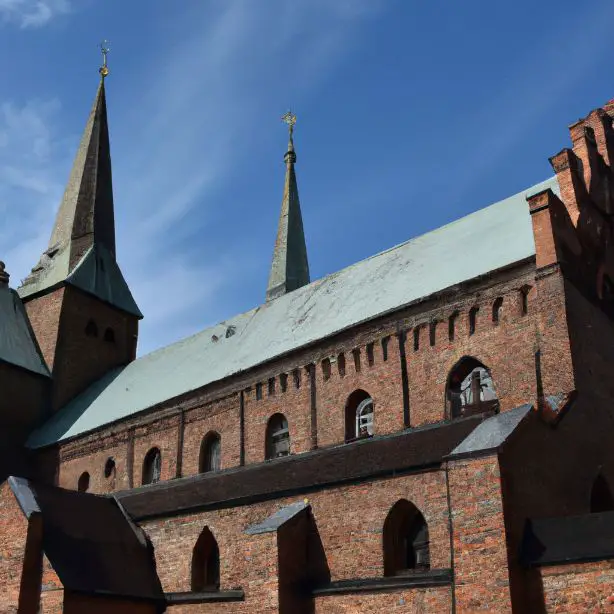Odense Cathedral (Odense) : Interesting Facts, Information & Travel Guide

- By
- Aparna Patel
- |
- 15 Jun, 2023
- |

Welcome to the world-famous Odense Cathedral, located in the stunning Danish city of Odense. The cathedral is one of the most historic religious structures in Europe, dating back to the 1100s, and has recently been restored to its former glory. Today the cathedral stands as a cornerstone of Danish culture, playing host to a variety of events and activities. In this blog, we’ll look at some interesting facts and information about the cathedral, as well as some great ideas for a visit to this historic site. So, without further ado, let’s dive into the world of Odense Cathedral.
Table of Contents
Interesting Facts About Odense Cathedral (Odense)
1. Odense Cathedral is the oldest cathedral in the Danish mainland, with the first church structure dating back to 1086.
2. The current main structure of the cathedral was built between 1145 and 1250 in a mix of Romanesque and Gothic styles.
3. The cathedral is the burial place of two noble Danish families, the Race of Lindenborg and the Schackenborg Family.
4. The cathedral’s impressive altar dates from 1621 and is decorated with figures from the Old Testament.
5. The main tower of the cathedral was added in the 15th century, and is the tallest structure in the city of Odense.
6. The crypt of the cathedral is home to the skeletal remains of King Canute IV, who was murdered in 1086 at the instigation of his half-brother Ebbe Suneson.
7. Unlike most other Cathedrals in Europe, Odense Cathedral is not a Bishop’s seat, but the parish church of the bishop of the Fyns Stift diocese.
8. Odense Cathedral houses a well-preserved 13th century statue known as the “Lettered Madonna,” depicting the Virgin Mary holding the baby Jesus.
9. In 2017, the Danish government invested a large amount of money to ensure that the Viking roots of the cathedral were uncovered and preserved.
10. The crypt of the cathedral is home to the oldest still-working pipe organ in Scandinavia.
History & Information About Odense Cathedral (Odense)
The Odense Cathedral (Latin: Sankt Knuds Kirke) is a medieval-era Lutheran church in Odense, Denmark. It is the burial site of Saint Canute IV of Denmark (or Saint Knud) and is the seat of the Bishop of Odense. The Odense Cathedral has been a popular pilgrimage site since the Middle Ages and is one of the greatest examples of Gothic architecture in Northern Europe.
The construction of the cathedral began in the 12th century, during the reign of King Eric I of Denmark. It was originally part of a Benedictine monastery, but in 1350 it was converted into a royal chapel for Queen Margaret I of Denmark. After her death, the cathedral became the center of Odense’s religious life when the reformed church, Lutherism, began to gain traction in Denmark in the 1520s. During the Reformation, most of the cathedral’s interiors were demolished except for its towers and choir.
Today, the Odense Cathedral stands in its original medieval Gothic splendor. It originally housed a collection of royal tombs, although today the only remaining tomb is that of Saint Canute IV of Denmark. The interior of the cathedral is adorned with numerous impressive works of art, including Romanesque frescoes, 15th-century altarpieces, and a Renaissance-era bronze font, among other things. The church also features a large organ installed in 1998, which is one of the largest in Scandinavia.
In recent years, the Odense Cathedral has been the site of royal events, such as the 2011 wedding of Crown Prince Frederik of Denmark and Crown Princess Mary. The cathedral continues to play an important role in the city of Odense, as well as a spiritual role for the nation as a whole.
- Aalborg: Interesting Facts, Culture & Things To Do
- Aros Aarhus Art Museum (Aarhus) : Interesting Facts, Information & Travel Guide
Travel Guide For Visiting Odense Cathedral (Odense)
1. Location:
Odense Cathedral (Odense Domkirke) is located in the center of Odense, Denmark and can be visited at Kirkestræde, 5000 Odense C, Denmark.
2. Hours:
The church is open to visitors most days of the week, from 10 am until 5 pm.
3. Admission:
Admission to the church is free.
4. What to See:
The church has been recently renovated and features gorgeous stained-glass windows, wooden sculptures, and a 14th-century altar. The church also holds important historical artifacts such as royal tombs, various artworks from the 16th century, and various other dates.
5. Nearby Attractions:
Odense Cathedral is located just a few steps away from Denmark’s oldest town, with plenty of shops, restaurants, and other attractions. Within walking distance of the cathedral, there are various museums, including the Odense City Museum, The Funen Village, and the Odense Zoo.
Frequently Asked Questions About Odense Cathedral (Odense)
Q: When was Odense Cathedral built?
A: The present Odense Cathedral was built in the early 13th century on the site of an older church consecrated in 1086.
Q: What is the architecture of Odense Cathedral?
A: Odense Cathedral is an example of Gothic brick architecture. Its exterior is covered with creamy-white brick, and its main supports are huge buttresses. The interior features a mixture of Gothic and Baroque styles.
Q: How long is the cathedral?
A: The length of Odense Cathedral is approximately 81 meters.
Q: Who is buried in Odense Cathedral?
A: The most famous ruler who is buried in Odense Cathedral is King Canute IV, also known as Canute the Holy. He was a Viking king who was slaughtered in the 1090 Battle of Sinsheim.
Q: What other attractions are located near Odense Cathedral?
A: Near Odense Cathedral, tourists can find the Hans Christian Andersen House Museum, the Funen Village open-air museum, and St. Canute’s Cathedral.
Search Posts
Latest posts
-
4 Mar, 2024
Why are there no seat belts on trains?
Popular posts
-
5 Mar, 2024
Why prohibit engine braking?